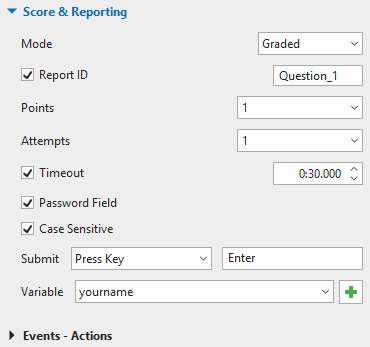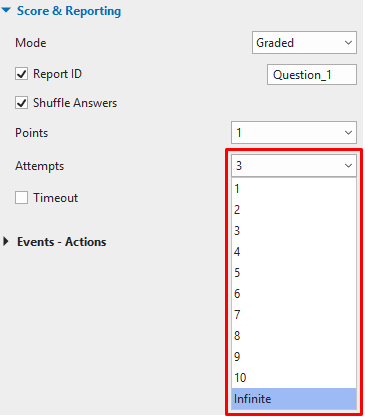In creating eLearning content, defining how to score and report learning outcomes is one of the most important tasks, especially when you need to track the result of online learners. This article will cover how to define the score and report of interactive questions in ActivePresenter 8.
Before we start, note that you can find all of the defining options in the Score & Reporting section of the Properties pane. Besides, depending on the question types you are creating, the properties in this section may vary.

Let’s get into details.
Question Mode

First, you need to select a question mode, which is Graded or Survey.
The Survey mode is for collecting viewer feedback, information, or ideas, so, it doesn’t allow score setting. You can use this mode to create surveys. On the other hand, the Graded mode comes with many properties, including defining points, report ID, max timeout, etc. Consequently, the Graded mode is good to go if you are creating an eLearning course and need to track the learners’ results.
Question Report ID

Report ID is critical when it comes to reporting learners’ results via an LMS because it’s used to identify different reporting elements. Normally, these values are generated automatically by ActivePresenter. However, you should make them more meaningful, helping you follow the report easily.
For instance, if you are creating a game with multiple questions, you should let the report ID of each question be a different value (e.g. Question_1, Question_2). Thanks to that, you can see clearly and exactly from the report which answers are correct and which are not.
Note: The report ID can contain alphanumeric characters (A-Z, a-z, 0-9) and underscore (_) with a maximum length of 250 characters.
Tip: For more information about how to report and track the content in an LMS, see Tracking Training Courses in an LMS with ActivePresenter 8.
Shuffle Answers of Question

For the reason that users can remember the order of answers hence guess the correct ones, you’d better shuffle them. The order of answer choices will change each time learners retake the test.
Points Gained for Each Correct Answer

In taking tests, one thing that learners care about is how many points they can get for each correct answer. You can define this information by entering a value in the Points box or select one from the list.
Besides, a question can have more than one correct answer (Multiple Response, Fill in Text Entry, Fill in Text Entries, Fill in Blanks, Drag-n-Drop and Hotspot) and they don’t necessarily have to be equal in points. You can give each of them a different point. Just select Partial from the Point list and then enter a number in the Point box of each correct answer.
For more information about how to work with partial score in different question types, please take a look at this tutorial.
Tip: It’s common when points are accumulated when learners have correct answers. On the contrary, if you want points to be taken away when users give incorrect responses, enter a negative number in the Point box of each wrong answer of the question. Remember to select the Partial point beforehand.
Question Max Attempt

You can set the maximum number of attempts that users can make before objects are disabled by entering a value in the Attempts box. Furthermore, for the game or test with an infinite number of attempts (within the time limit), select Infinite. Users will be able to make as many attempts as they wish before reaching the time limitation (if any).
Question Timeout

It’s a common case that questions in a quiz have different levels of complexity. For that reason, the amount of time users need to complete them is different.
With that in mind, ActivePresenter allows you to define the timeout for each question individually by entering a value in the Timeout box. Users have to answer the question within this time limit. When the time is out, they cannot interact with objects anymore.
Note: Defining the total max time of the whole test (contain multiple questions) also comes in handy. Refer to Setting Pass/Fail Condition for Lessons for details.
Password Field

When selecting this option, whatever users enter in the text box will display as asterisks, keeping the user’s information (e.g. password) private. Just select the Password Field check box to enable this feature.
Case Sensitive

Some questions don’t require learners to match or select correct answers but to type text or numbers instead. Occasionally, uppercase and lowercase letters should be treated differently. This requires users to enter exactly each small and capital letter to have correct answers. For that to happen, just select the Case Sensitive check box.
Submit

ActivePresenter provides you with two methods to submit entered values of the text box. The submission can be automatic (Auto) or manual (Press Key).
- Press Key: The value in the text box is validated when users press the preset key.
- Auto: Whenever users press any key, the values in the text box are validated. As long as the entered text is a partial match for the reference text (the correct value), ActivePresenter will wait for the user to input more text. However, the moment the last character is found to be different, it will be deemed as incorrect.
If the entered text matches the reference text, ActivePresenter displays a Correct message. On the other hand, if the entered text does not match the reference text, ActivePresenter displays an Incorrect message.
Variable

ActivePresenter 8 makes assigning variables to text boxes of the question possible, allowing storing and retrieving dynamic information throughout the content. You can select one system variable from the Variable list or create new variables.
Above are steps to define score and report for interactive questions. After doing these steps, you may want to have a report slide where users’ performances are displayed.
For more information, see how to review a course.
So, you have learned how to define score and report for interactive questions in ActivePresenter 8. Hope that it helps.
See the following tutorials for more information about using variables in ActivePresenter 8: